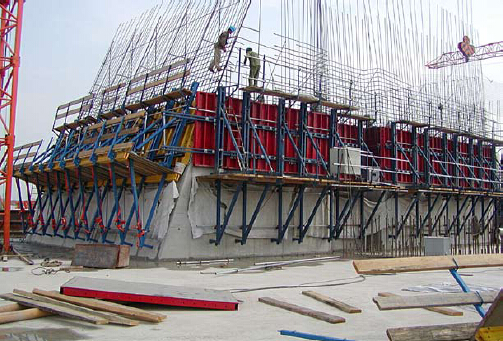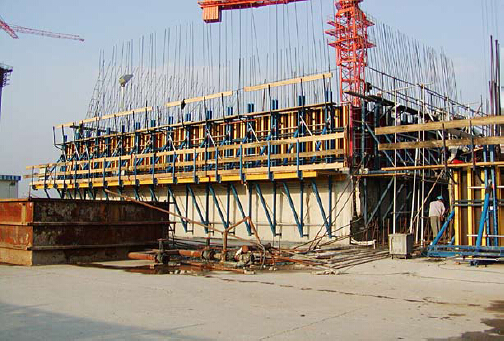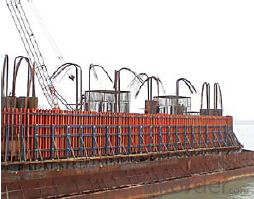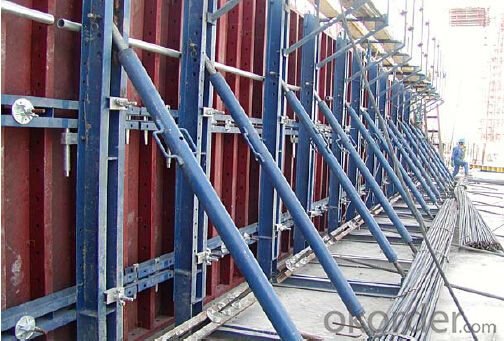Single-side climbing bracket SCB180 for formwork and scaffolding system
- Loading Port:
- Tianjin
- Payment Terms:
- TT OR LC
- Min Order Qty:
- 50 m²
- Supply Capability:
- 1000 m²/month
OKorder Service Pledge
OKorder Financial Service
You Might Also Like
Single-side Climbing Bracket SCB180:
With CNBM SCB 180 climbing systems, the loads from the fresh concrete pressure are transferred through the brackets by means of V-strongbacks and compression braces into the scaffold anchors.
Typical applications for the SCB 180 are dams, locks, cooling towers, pier heads, tunnels, and bank vaults.
The formwork is simply tilted backwards when striking takes place. The 1.80 m wide bracket requires only a minimum of space.
Characteristics:
◆ Economical and safe anchoring
The M30/D20 climbing cones have been designed especially for single-sided concreting using
SCB180 in dam construction, and to allow the transfer of high tensile and shear forces into the still
fresh, unreinforced concrete. Without wall-through tie-rods, finished concrete is perfect.
◆ Stable and cost-effective for high loads
generous bracket spacings allow large-area formwork units with optimal utilization of the bearing
capacity. This leads to extremely economical solutions.
◆ Simple and flexible planning
With SCB180 single-sided climbing formwork, circular structures can also be concreted without
undergoing any large planning process. Even use on inclined walls is feasible without any special
measures because additional concrete loads or lifting forces can be safely transferred into the
structure.


- Q: What are the considerations when designing steel formwork for beams?
- When designing steel formwork for beams, there are several important considerations to take into account. Firstly, the formwork needs to be strong and durable enough to support the weight of the concrete and any additional loads, such as construction personnel or equipment. The formwork should also be designed to withstand the pressure and vibrations caused by the pouring and consolidation of the concrete. Additionally, the formwork should be designed to provide easy access for placing and compacting the concrete. This may involve incorporating openings or removable sections to allow for the proper placement and consolidation of the concrete. Furthermore, the design should consider the ease of assembly, disassembly, and reusability of the formwork. Steel formwork is often preferred due to its strength and reusability, so the design should be efficient in terms of assembly and disassembly to minimize labor and time. Lastly, safety is a crucial consideration. The formwork should be designed to ensure the safety of workers during the construction process. This may involve incorporating features such as guardrails, non-slip surfaces, or other safety measures to prevent accidents or falls. In summary, when designing steel formwork for beams, factors such as strength, durability, accessibility, reusability, and safety should all be carefully considered to ensure a successful and efficient construction process.
- Q: Can steel formwork be used in heritage or conservation projects?
- Yes, it is possible to utilize steel formwork in heritage or conservation projects. Steel formwork possesses numerous advantages that render it appropriate for such endeavors. Firstly, steel formwork exhibits exceptional durability and longevity, making it indispensable when working on historical structures that necessitate preservation for future generations. It can endure the challenges of construction and can be reused multiple times, thus offering a cost-effective solution. Furthermore, steel formwork provides outstanding strength and stability, guaranteeing accurate and precise concrete placement. This is particularly critical in heritage projects where maintaining the original design and structural integrity is paramount. The adaptability of steel formwork also enables the replication of intricate detailing and complex shapes, thereby making it suitable for recreating historic architectural features. Moreover, steel formwork is highly resistant to warping, shrinking, or expanding due to temperature fluctuations and moisture, which are often encountered in conservation projects. This resistance ensures the formwork's stability throughout the construction process, reduces the risk of harm to the heritage structure, and aids in preserving the overall structural integrity. Nevertheless, it is crucial to take into account the specific requirements and limitations of each heritage or conservation project. Certain projects may have stringent guidelines mandating the use of traditional materials, rendering steel formwork unsuitable. It is imperative to consult with heritage experts and conservation specialists to ensure that the use of steel formwork aligns with the project's objectives and adheres to all necessary preservation standards.
- Q: Can steel formwork be used in hotel or hospitality construction projects?
- Yes, steel formwork can be used in hotel or hospitality construction projects. Steel formwork offers several advantages over other types of formwork, such as wood or concrete. Firstly, steel formwork is highly durable and can withstand the heavy loads and pressures associated with construction projects. This makes it suitable for use in the construction of hotels, which often require large and complex structures. Secondly, steel formwork is reusable, which can result in cost savings and reduced construction time. This is particularly beneficial for hotel or hospitality construction projects, where the construction process needs to be efficient and timely. Additionally, steel formwork provides a smooth and high-quality finish to concrete surfaces, which is important in the hotel and hospitality industry where aesthetics play a significant role. The smooth finish of steel formwork can enhance the overall appearance of the hotel, creating a more visually appealing and luxurious environment for guests. Furthermore, steel formwork allows for greater flexibility in design, as it can be easily shaped and adjusted to meet specific project requirements. This is advantageous in hotel or hospitality construction projects, where unique and customized designs are often desired to create a distinctive and memorable guest experience. In conclusion, steel formwork can indeed be used in hotel or hospitality construction projects due to its durability, reusability, ability to provide a smooth finish, and flexibility in design.
- Q: How does steel formwork affect construction speed and efficiency?
- Steel formwork can significantly enhance construction speed and efficiency in several ways. Firstly, steel formwork is highly durable and can withstand multiple uses, resulting in reduced time and cost associated with replacing or repairing formwork materials. This allows construction projects to progress smoothly without delays caused by formwork damage or deterioration. Moreover, steel formwork provides a high level of accuracy and precision during the construction process. Its rigid structure ensures consistent dimensions and alignment, resulting in uniformity in concrete placement and reducing the need for adjustments or corrections. This precision saves time and effort, enabling construction teams to work more efficiently and complete projects in a timely manner. Additionally, steel formwork is known for its versatility and adaptability. It can be easily customized to fit various shapes and sizes, allowing for the construction of complex structures with ease. This flexibility eliminates the need for extensive manual cutting or modification of formwork materials, saving time and labor. Furthermore, steel formwork offers a quick assembly and dismantling process. Its modular design allows for easy installation and removal, reducing the time required for formwork preparation and cleanup. This efficiency not only accelerates construction progress but also minimizes downtime between different stages of the project. Lastly, steel formwork is known for its excellent load-bearing capacity. Its sturdy construction can support heavy concrete loads, enabling faster construction cycles by allowing for larger pours and reducing the number of pour breaks. This increases the productivity of the construction team, as they can complete larger sections of the structure in a shorter period. In conclusion, steel formwork positively impacts construction speed and efficiency by providing durability, accuracy, versatility, quick assembly, and load-bearing capabilities. Its contribution to reducing construction time, minimizing errors, and optimizing resource utilization makes it a preferred choice for many construction projects.
- Q: How does steel formwork contribute to the overall sustainability of a construction project?
- There are several ways in which steel formwork contributes to the overall sustainability of a construction project. To begin with, steel formwork is highly durable and can be reused multiple times. This means that less waste is generated during the construction process, unlike traditional timber formwork which is typically discarded after only a few uses. By reducing waste, steel formwork helps conserve natural resources and decreases the environmental impact of the construction project. Furthermore, steel formwork is renowned for its strength and stability, enabling the construction of more robust structures. Consequently, buildings constructed using steel formwork are likely to have a longer lifespan, reducing the need for frequent repairs or reconstruction. The longevity of steel formwork contributes to the overall sustainability of a construction project by minimizing the resources and energy required for maintenance and renovation over time. In addition, steel formwork allows for faster construction as it can be easily assembled and disassembled. The efficiency and speed of steel formwork result in shorter construction periods, which in turn reduces the energy consumption and carbon emissions associated with construction activities. This is especially crucial in today's fast-paced construction industry, where reducing time on site is a key factor in achieving sustainable development goals. Moreover, steel formwork provides a higher quality finish to concrete structures, which can enhance the overall energy efficiency of a building. A smooth and precise finish achieved through steel formwork can reduce the need for additional insulation or cladding, thereby decreasing the energy required for heating or cooling the building. This not only benefits the environment but also improves the energy efficiency and comfort of the occupants. In conclusion, steel formwork contributes to the overall sustainability of a construction project by reducing waste, increasing durability, shortening construction time, and improving energy efficiency. By opting for steel formwork, construction projects can adopt a more sustainable and environmentally friendly approach, benefiting both the immediate project and the long-term impact on our planet.
- Q: Can steel formwork be used in areas with high humidity levels?
- Yes, steel formwork can be used in areas with high humidity levels. Steel is a durable and corrosion-resistant material, which makes it suitable for use in humid environments. However, it is important to ensure proper maintenance and protective coatings are applied to prevent rust and corrosion. Additionally, using steel formwork in high humidity areas may require more frequent inspections and maintenance to ensure its longevity and structural integrity.
- Q: Can steel formwork be used for hospital construction projects?
- Yes, steel formwork can be used for hospital construction projects. Steel is a strong and durable material that can provide the necessary support and stability required for constructing hospitals. It is capable of withstanding heavy loads and can be easily customized to meet the specific requirements of hospital structures. Additionally, steel formwork offers the advantage of being reusable, which makes it a cost-effective choice for construction projects of this nature.
- Q: Can steel formwork be used in areas with limited labor availability?
- Yes, steel formwork can be used in areas with limited labor availability. Steel formwork is known for its durability and reusability, making it suitable for areas where labor is scarce. It requires minimal manual labor for assembly and disassembly, reducing the need for a large workforce. Additionally, steel formwork systems are designed to be easily transported and installed, allowing for efficient construction processes even in areas with limited labor resources.
- Q: What are the considerations when designing a steel formwork system?
- When designing a steel formwork system, there are several key considerations that need to be taken into account. These considerations include: 1. Structural Integrity: The steel formwork system must be designed to have sufficient structural integrity to withstand the loads and pressures exerted by the wet concrete during the pouring and curing process. This includes ensuring that the formwork is strong enough to prevent any deformation or failure, as well as considering the appropriate thickness and reinforcement of the steel components. 2. Durability: The formwork system should be designed to be durable and long-lasting, as it will be subjected to multiple uses and may need to be reused for different construction projects. The steel used should be corrosion-resistant, and all components should be properly coated or protected to prevent rust and deterioration over time. 3. Flexibility and Adaptability: The design of the steel formwork system should allow for flexibility and adaptability to different construction requirements. This includes considering the ability to easily adjust the formwork to accommodate different shapes, sizes, and configurations of concrete structures. The system should also allow for easy assembly, disassembly, and reconfiguration to facilitate efficient and cost-effective use. 4. Safety: Safety is a crucial consideration when designing a steel formwork system. The design should incorporate proper safety features, such as guardrails, handrails, and non-slip surfaces, to prevent accidents and ensure the well-being of workers. Additionally, the formwork system should be designed to minimize the risk of concrete blowouts or collapses, and appropriate measures should be taken to ensure the stability and rigidity of the system. 5. Cost-effectiveness: The overall cost-effectiveness of the steel formwork system should be considered during the design phase. This includes evaluating the initial cost of materials and fabrication, as well as the potential for reuse and the ease of maintenance. The design should strive to minimize waste, maximize efficiency, and ultimately provide a cost-effective solution for the construction project. In summary, when designing a steel formwork system, considerations should include the structural integrity, durability, flexibility and adaptability, safety, and cost-effectiveness of the system. By addressing these considerations, a well-designed steel formwork system can contribute to the successful and efficient completion of a construction project.
- Q: How does steel formwork compare to plywood formwork?
- Steel formwork and plywood formwork are commonly used materials in construction for creating molds or frameworks for concrete structures. Both materials have their pros and cons, but steel formwork generally has several advantages over plywood formwork. One of the main benefits of steel formwork is its durability and longevity. Steel is a strong material that can handle heavy loads and repeated use without losing its structural integrity. Unlike plywood, which can warp, expand, or deteriorate over time due to moisture, steel formwork can be used for multiple projects, making it a cost-effective choice in the long term. Another advantage of steel formwork is its precision and accuracy. Steel molds can be manufactured with great precision, ensuring that the final concrete structure meets all the required specifications. This is especially important for complex or intricate designs where accuracy is crucial. Plywood formwork may not provide the same level of precision due to its flexibility and susceptibility to warping. Steel formwork also offers improved safety features. Due to its rigidity and strength, steel molds provide a stable and secure working platform for construction workers. This reduces the risk of accidents and injuries during the concrete pouring and curing process. Plywood formwork, although commonly used, may have a higher risk of collapse or failure, especially in large-scale projects or areas with adverse weather conditions. Furthermore, steel formwork can be easily assembled and disassembled, allowing for efficient and quick construction processes. Steel molds are usually prefabricated and can be easily transported to the construction site, minimizing the need for on-site carpentry work. Plywood formwork, on the other hand, requires more time and effort to set up and dismantle, resulting in longer construction timelines and increased labor costs. However, it is important to note that steel formwork is generally more expensive upfront compared to plywood formwork. The initial cost of steel molds may be higher, but their long-term value and durability make them a worthwhile investment, especially for large construction projects or projects that require repetitive use of formwork. In conclusion, while both steel formwork and plywood formwork have their advantages, steel formwork offers several benefits in terms of durability, precision, safety, and efficiency. Despite the higher initial cost, steel formwork is a reliable and cost-effective choice for construction projects, particularly those that require high-quality finishes and complex designs.
Send your message to us
Single-side climbing bracket SCB180 for formwork and scaffolding system
- Loading Port:
- Tianjin
- Payment Terms:
- TT OR LC
- Min Order Qty:
- 50 m²
- Supply Capability:
- 1000 m²/month
OKorder Service Pledge
OKorder Financial Service
Similar products
Hot products
Hot Searches


















